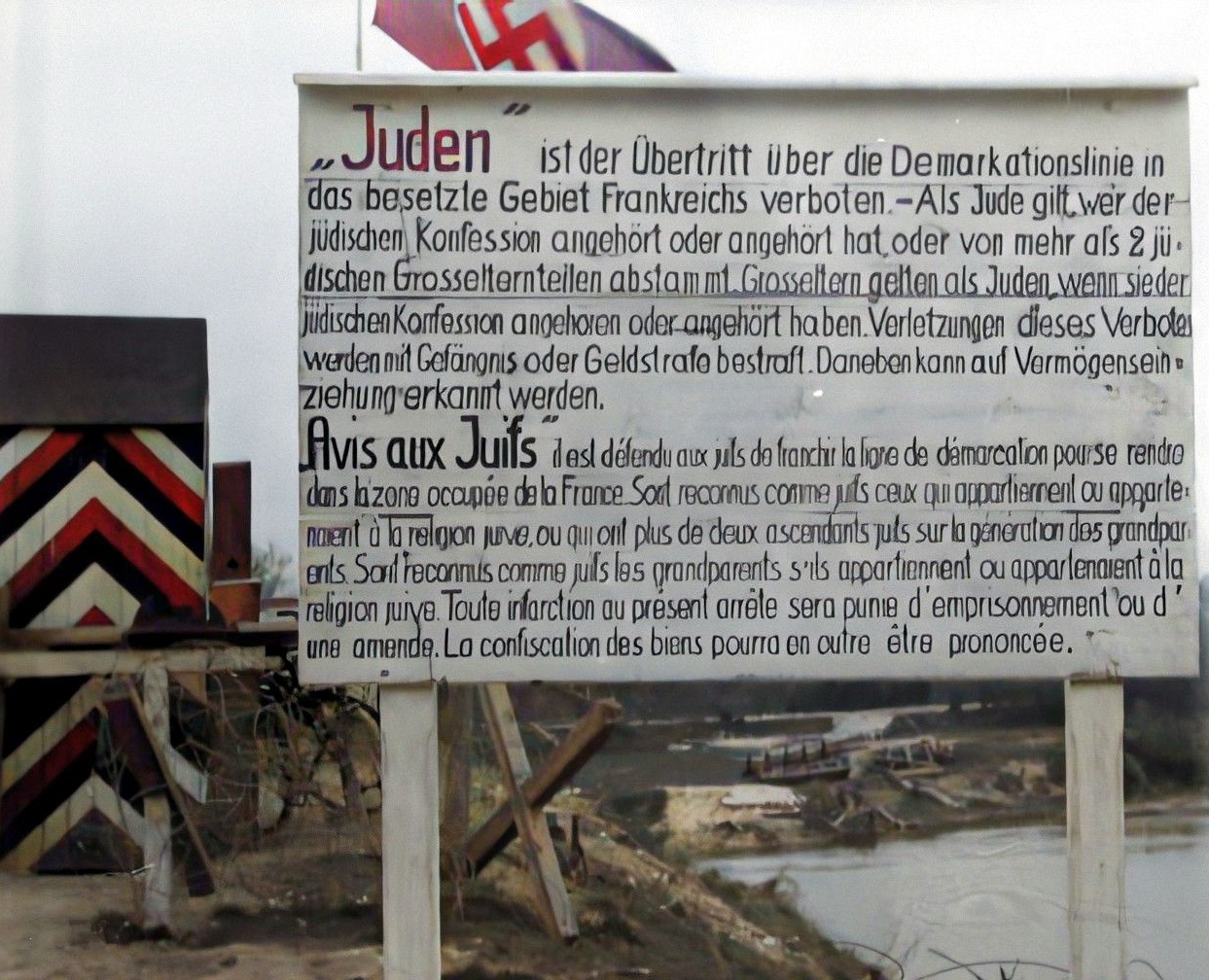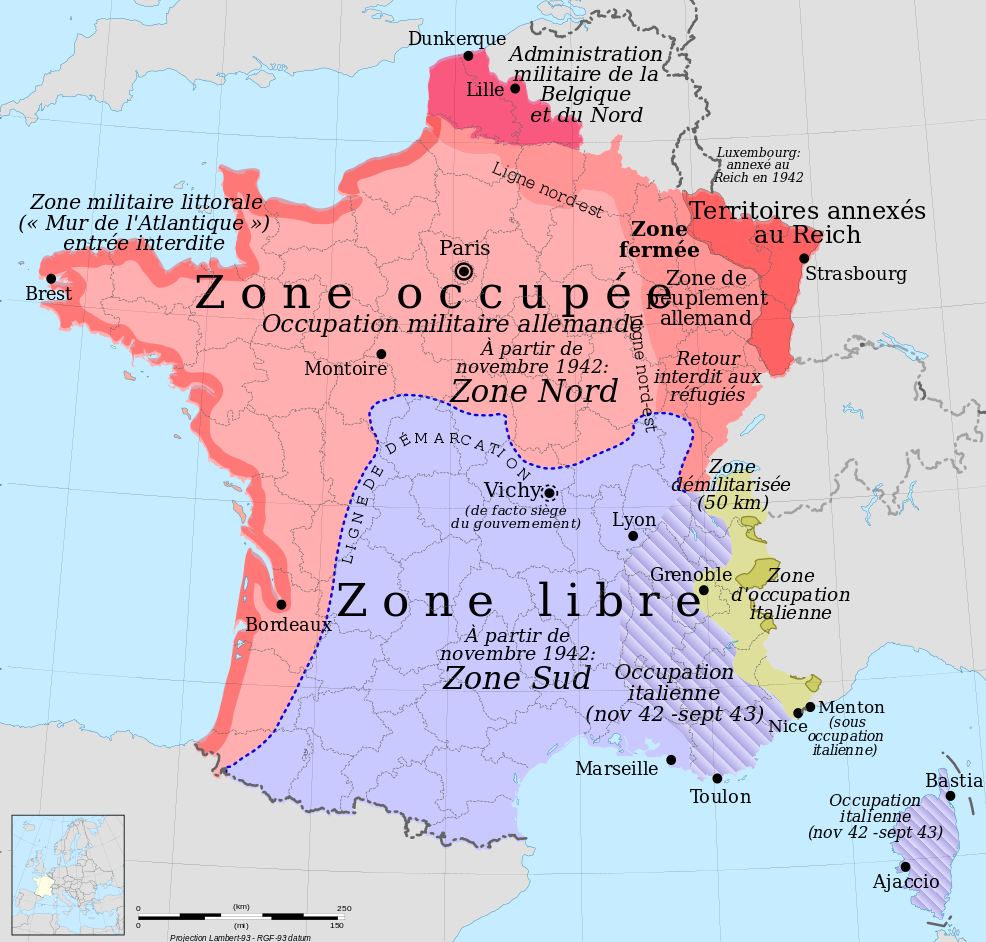Mapping a tragedy: the Jews in France and Belgium (1940-1944)
Between 1940 and 1944, the borders of the French Republic and the Kingdom of Belgium gave way to
- occupied (by Germany or Italy) and non-occupied zones
- prohibited or annexed zones
This new division itself evolved between 1942 and 1943.
Depending on the time and the place, the situation of the persecuted and then hunted down Jews presented unfavorable or very unfavorable factors.
To escape the measures that targeted them, many Jews (often foreigners) moved from one zone to another.
Here are a few points of reference to help you find their traces…
OCCUPIED ZONES
(1940 -1944)
The two military administrations of the German occupation : occupied Belgium and France
These administrations were headed by senior army officers with the title of « military commander » (Militärbefehlshaber). They were military governors who were responsible for « the control and supervision of the administration and economy of the occupied country, including the exploitation of the country for the needs of the occupying troops and the German war economy ».
The occupation policy was based on the collaboration of the national administrations.
These occupation regimes established anti-Jewish ordinances that led to the deportation of all Jews located in these territories after 1942.
• Belgium under occupation
The military occupation zone called « Belgium » differs from the real Belgian territory:
- it did not cover the districts of Eupen and Malmédy (annexed) (no Jewish presence)
- it extended to the French departments of Nord and Pas-de-Calais (including the Jewish forced labor camps of the Atlantic Wall).
During most of the occupation, the German military commander (Militärbefehlshaber) in Brussels was General Alexander von Falkenhausen.
The Gestapo and the SS also dealt with the Jews in this area.
• The French zone occupied by Germany
This military zone of occupation included the entire northern half of present-day France as well as its western seaboard (from Dunkirk to Saint-Jean-de-Luz).
As a result, Paris and most of the French industries were under the German occupation regime.
The German military commander in France (Militärbefehlshaber in Frankreich) based in Paris (Otto von Stülpnagel until February 1942) was initially the supreme representative of German power in occupied France. But a German « ambassador » was also appointed, who was also the unofficial interlocutor of the Vichy regime (see below).
Tens of thousands of Jews obviously lived in this zone.
• The French zone occupied by Italy
Fascist Italy occupied only a limited border area covering mainly the city of Menton (with attempts at Italianization) and fortifications along the Alpine border (Alpes maritimes, Basses Alpes -Alpes-de-Haute-Provence since 1970, hautes Alpes, Savoie).
NON-OCCUPIED ZONE
1940-1942
• The non-occupied French zone (Vichy government)
This zone, established by the 1940 armistice treaty, covered the south of the current French metropolis as well as the three Algerian departments and the territories of the French colonial empire.
It was run by a government known as the « French State », which was based in the spa town of Vichy (Pétain).
The Vichy government was hostile to foreign Jews and to Jews who were French citizens (e.g. the family of Simone Veil). Its first anti-Jewish law preceded the introduction of the first German anti-Jewish ordinances in German-occupied France.)
In the non-occupied zone, Vichy organized a systematic round-up of all foreign Jews in August 1942. They were deported via the Drancy assembly camp (Paris).
In principle, Vichy retained hierarchical authority over the state services in the other zones. In reality, this authority only served to collaborate with the occupying powers (as in the case of the French collaboration against the Parisian Jews – the « Greenback Roundup », the « Vel d’hiv » …).
The Vichy regime continued to exist after November 1942 but the zone was occupied by Germany and Italy.
Between occupied and non-occupied France : the demarcation line
This demarcation line extended from the Swiss border (at Geneva) and passed through Dole, Moulins, Bourges, Tours, Angoulême, Mont-de-Marsan, to Saint-Jean-Pied-de-Port. Its route does not respect the limits of the departments it crosses.
It was an almost watertight internal border: the circulation of people, goods and mail was very restricted. It was an obstacle for the persecuted Jews who tried to reach the southern zone (initially reputed by mistake as less unfavorable) and initially less supervised.
The demarcation line was maintained after the invasion of the non-occupied zone in 1942.
THE TURNING POINTS OF 1942 AND 1943
• November 1942: the end of the unoccupied zone
From the German point of view
German troops invaded this area in reaction to the Allied landing in North Africa.
In the newly occupied zone, the military administration had to deal with the most pressing problems: maintaining order and repression, organizing the economy, etc.
During this period, until the liberation in 1944, the only chance of survival for the Jews was to live in hiding.
From the Italian point of view
In consultation with the German ally, Italian troops occupied Corsica, Nice and an area along the left bank of the Rhône. Cities such as Lyon, Marseille, Aix and Avignon were under German control.
In their zone of occupation, the Italian authorities protected the Jews from the Nazis and Vichy. Forced residence » centers (Vence and Saint-Martin-Vésubie) served as their protection.
• September 1943: the end of the Italian occupation
Jews under Italian occupation escaped to Italy in September 1943 (armistice between the Italians and the Allies).
Mussolini’s regime collapsed (Italian Social Republic of Salò).
PROHIBITED, RESERVED OR ANNEXED ZONES
1940-1944
• Annexation of Alsace-Lorraine
Alsace-Lorraine became part of the Reich.
The department of Moselle joined the Saarland in the Gau (region) of the « Western March » (Westmark) (subordinated to the Gauleiter of Saarbrücken) and the departments of Upper and Lower Rhine merged with the Land of Baden (under the authority of the Gauleiter of Karlsruhe who moved part of his services to Strasbourg).
This annexed area was subjected to forced Germanization. As a result, the inhabitants of the zone who were declared unassimilable were expelled to France.
Thus, several thousand French Jews from Alsace and Lorraine were expelled to the non-occupied zone. Their property, interests and rights were confiscated for the benefit of Germany.
Some of the expellees settled around Limoges or found themselves in Vichy internment camps.
• The forbidden zone between the Nord-Pas-de-Calais and the French zone occupied by Germany
A « forbidden zone » closed off the passage and return of people who had taken the road to exodus in the summer of 1940. It isolated the Nord-Pas-de-Calais (Belgian zone under German occupation) from the French zone under German occupation. This forbidden zone was delimited by a line running from the Somme estuary to the Ardennes, passing through Amiens and between Laon and Reims, as well as Mézières.
• The reserved zone between Alsace-Lorraine and the German occupied zone
This area is quite comparable to the old western border of the Holy Roman Empire. It follows a line connecting Mézières, Bar-le-Duc, Langres, Dôle.
Prohibited or reserved areas for agricultural use for the benefit of Germany
A German agricultural company was founded in February 1940 for the purpose of agricultural colonization of certain Polish territories conquered the previous year.
After the victory of 1940, the Ostland (short for Ostdeutsche Landbewirtschaftungsgesellschaft, East German Agricultural Society) also moved westward in the two areas mentioned above.
The Ostland mainly took over farms that had no owners (farmers who had fled and were prevented from returning or who were prisoners of war) or confiscated them. These measures generally did not affect Jews living in France at the time.



